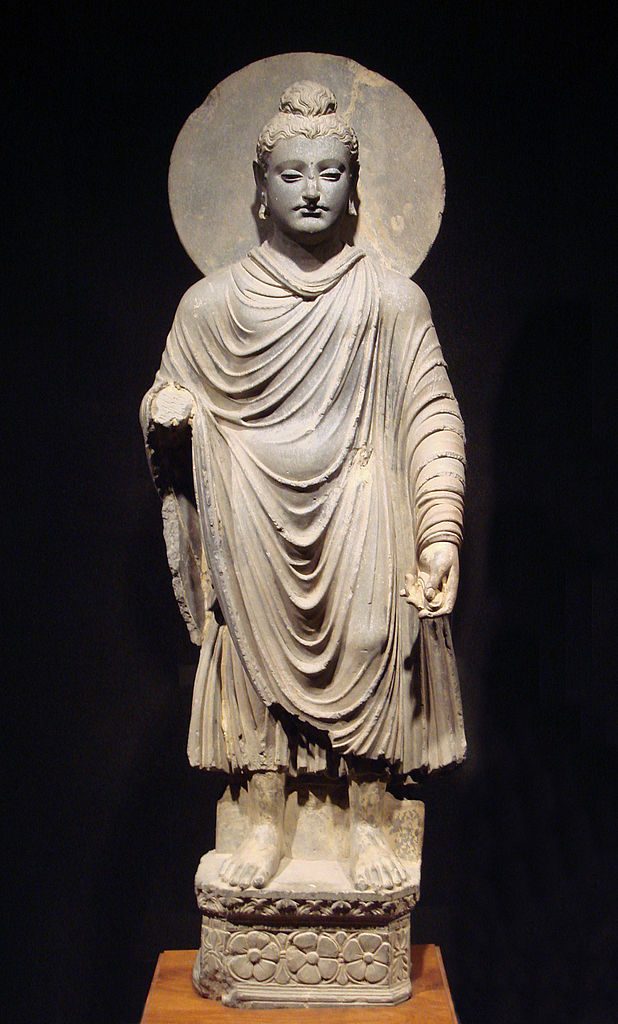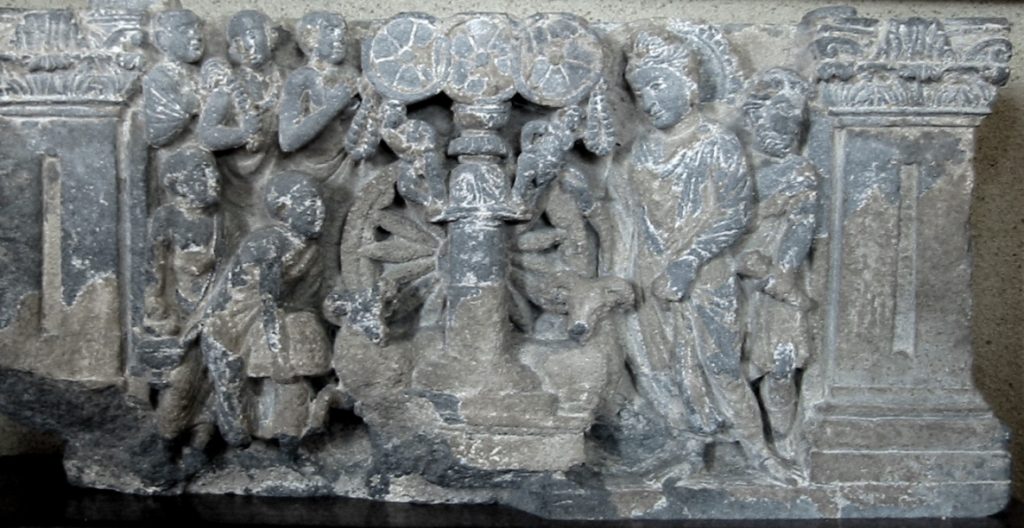Serial causation leading to entanglement
“This is, because that is. This is not, because that is not. This ceases to be, because that ceases to be.”
The doctrine of anatman – no-self – and that of pratityasamutpada, translated as “co-dependent origination,” or “co-dependent arising,” or “conditioned arising” are closely related. In the former, Buddhism is formulated in the language of the Upanisads as a denial of the existence of atman in the sense of an unchanging independent self. In the latter, we find the Buddha’s own understanding of the pluri-causal process we mistakenly call our “selves.” I talked about anatman in the previous page. Here I focus on co-dependent origination.

Just as was the case with anatman, co-dependent origination is traced back to the time of the Buddha’s enlightenment, and it has been included in the teachings of all schools of Buddhism. To Govind Chandra Pande’s statement that “the obscurity of this formula is …well known, and it has long been a puzzle to scholars,” Gombrich adds that “the texts themselves seem to acknowledge this.”
In fact, it is the insight which the Buddha himself had found too “difficult for ordinary comprehension.” He is said to have tried to teach it to Ananda, and Ananda had failed to understand it. For this reason, he “hesitated in preaching it.” Early Buddhist schools rarely refer to it, and one will have to wait until Nagarjuna’s famous equation between co-dependent origination, emptiness and the Middle Way, for it to take centre stage in Buddhist philosophy.
Part of the difficulty is the non-technical language the Buddha actually used: “This is, because that is. This is not, because that is not. This ceases to be, because that ceases to be.”
Stated in that way, the assertion could be taken to mean that correlation means causation. What the Buddha had in mind was not, however, the single cause and effect relation the West has focused on. It is instead a plural causality, or conditioned interpenetration, of all things whereby each thing arises in relation to all others, and can therefore be said to be conditioned by all others.
The Twelve Nidanas of the Wheel of Life

The language used by the the Buddha in his formulation of co-dependent origination, with its clear opposition between “is” and “is not,” makes perfect sense in the context in which it appears to have been worked out. To put an end to suffering, one had to understand the various stages of a serial process unfolding, step by step, and ultimately leading to suffering, death and rebirth, understood as yet another spell of suffering, life in the throes of impermanence being regarded as such, as sorrowful. It is then a matter of reversing the process through a path of practice, carefully explicited in the Noble Eightfold Path.
In the formula of the Twelve Links or Nidanas, the Buddha presents a chain of conditionally arising links whereby, because of ignorance – the naive assumption that all “things” have inherent (independent) existence – a process of psychological entanglement unfolds, with each link arising co-dependently with the next, finally resulting in suffering.
“Thus, dependent on ignorance, there arises volition; dependent on volition, there arises consciousness; dependent on consciousness, there arises mind and matter; dependent on mind and matter, there arises the sixfold sense bases, then, on with each nidana being dependent on the former, there arise contact, feeling, craving, grasping, clinging or attachment, becoming, birth, old age, death, sorrow, lamentation, pain, and despair.”
Plural causality here is presented as a serial chain of causation, a sort of runaway process of entanglement, rather than a simultaneous arising of different conditions – old age and death do not arise simultaneously with ignorance and volition. But it is clear that if ignorance ceases, as I learn that all things and conditions are just moments in a flux of impermanence, with no independent substantial existence, there would be nothing for me to crave for. So the process will cease and no suffering will result.
Of course, things are not that simple, because ignorance is not dispelled by “intellectual learning” alone. There must be an appropriation of what one learns. What has been understood by the mind must become embodied, so that it, as Buddhism phrases it, “becomes your bones and marrow.” This is where the practice comes in, as described in the Noble Eightfold Path. In the Pali Canon, the Buddha presents the Eightfold Path as a middle path between the extremes of sensual indulgence and self-mortification.
A psychological process of entanglement or a general system of interdependent causation?
It is often said that co-dependent origination refers to the Twelve Nidanas in the Theravada tradition, whereas in the Mahayana, it refers to a general system of interdependent causation.
As noted above, co-dependent origination is rarely mentioned in Theravada texts, whereas, starting with Nagarjuna, the doctrine comes to the fore, especially in Chinese Buddhism, where it expands into the metaphor of Indra’s Net encapsulating the teaching of the Huayan School.

It is really not surprising that the Buddha, for whom practice was key, focused on what we would call the “psychological” aspects of a path of practice aimed at cutting off attachments in our daily lives. What mattered to him was to show how each linkled to the next as a causal chain. When early Western scholars of Buddhism credited it with the quasi-discovery of “causality,” what they had been impressed with is this kind of serial causality. In addition, the Buddha accepted the Brahmanical equation of what has a cause – that is, whatever is the product of conditions – with its lack of ultimate reality. Co-dependent origination shows all things as mutually dependent on each other, so, empty of independent being, and therefore not really real: there is no point in getting attached to what is not really real. It can be argued then that the Buddha had a sense of the general system of co-dependent origination whereby all “things” arise in dependence upon each other, not just on a psychological level, but, we could say, at the cosmic level. But he was not interested in developing this standpoint at the level of concepts, pointing out, for instance, that all things manifest to us as pairs of opposites – hot and cold, long and short, good and evil, birth and death. He could have said, as later Buddhist thinkers have said, that, as I learn what “hot” is, I also learn what “cold” is, and this cannot be avoided as this is the way consciousness works: reality can only be apprehended by dualistic thought. However, at the very same time as I think the duality of all pairs of opposites, I also intuit their oneness in the notion of – here – temperature. This understanding of reality is actually very ancient as it formed the core teaching behind the Neolithic myth of the Great Mother metaphorically constructed on the natural cycle whereby out of the earth seeds germinate, grow into plants, which later die, dropping their seeds into the earth, out of which they will grow again at the beginning of the next cycle. The One “life” includes the duality of birth and death.
This myth endured for millennia after the Neolithic period and this apprehension of the cosmos as the One manifesting as Two, with the two being unreal as such, but revealing the One as the ultimate reality, was still alive in the Buddha’s time. But again, as the very ordinary and concrete language he used to convey the idea confirms, the Buddha was not interested in elaborating a theory of knowledge, and only saw the interdependence of the Two – that is, the many – in existential terms: how to overcome attachments to the ultimately illusory “many” so that release into the One is “gained” or rather, as the Buddha realised just before his enlightenment, “dropped into” as, from the standpoint of no-self, the many come to be seen and lived as no other than the One – the forms of the formless.
Source
Govind Chandra Pande – Studies in the Origins of Buddhism (1957)

